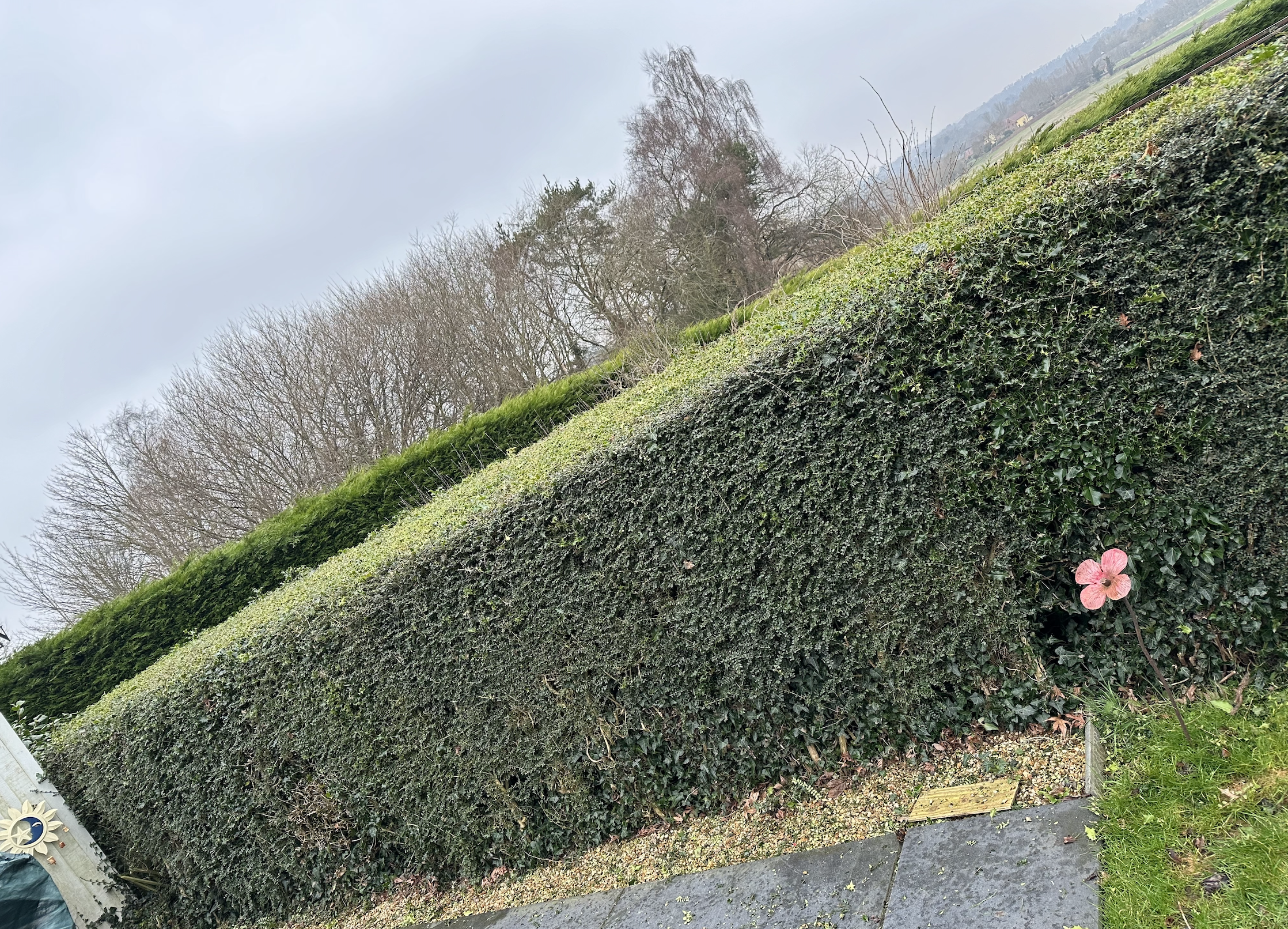
Knowing when to cut hedges is a key part of responsible gardening in the UK, especially in areas like Shropshire, where hedgerows play an important role in supporting local wildlife.
Many bird and animal species rely on hedges for shelter, nesting, and food. At Luxe Gardens, we manage hedge care with both beauty and biodiversity in mind, and we help our clients understand exactly when to cut hedges to support both.
Regularly prune and trim your hedgerow to promote dense, healthy hedges. Hedgerows with a mix of flowers, fruit, and seeds provide food and nesting sites for birds. Bird nesting season typically lasts from March to August every year, and cutting during this time can accidentally damage nests and disrupt breeding. Always check for signs of nesting before trimming to avoid harming protected species.
Cutting hedges at the right time not only stops disturbing birds but also helps plant health. Hedges also feed young birds by supporting insects and other food sources. The best times to trim are late winter and early autumn when most birds have finished nesting. Dense hedges can protect birds from predators and provide safe nesting sites. This means your hedges will be neat and thriving without harming local wildlife. We often work with clients to schedule these seasonal trims.
Proper garden waste management is another important consideration. Disposing of hedge clippings thoughtfully, by composting or using council collection services, keeps the environment clean and doesn’t harm small creatures that may be sheltering in piles of debris. Responsible disposal goes hand in hand with careful hedge maintenance for biodiversity.
Bird Nesting Season
Bird nesting season in the UK is from March to August, with the busiest time between March and July. During this time, many garden birds are busy building nests, laying eggs and raising their young, so it is important not to disturb eggs or nesting sites. Disturbing them can be fatal and is illegal.
Whilst nesting times can vary depending on the weather. A mild winter can bring some species forward, and a cold spring can delay them. So it’s always best to be aware and observe bird behaviour in your area before you do any hedge maintenance. Understanding when to cut hedges can help avoid disturbing nests during peak breeding months, ensuring your garden remains a safe space for wildlife while still being well cared for. If you’re unsure, professional gardeners, like our team at Luxe Gardens, can offer friendly advice or come take a look.
Different bird species like different hedges. Robins and blackbirds like low, dense hedges, while sparrows or finches prefer taller, thicker hedges. Binoculars can be used to monitor nests from a distance without disturbing the birds, making it easier to confirm nesting activity without causing stress. Being aware of when to cut hedges can make all the difference in avoiding disruption to these nesting spots. We’ve often helped spot these signs for clients during routine garden visits, as it’s not always obvious unless you know what to look for.
The Wildlife and Countryside Act 1981 gives all wild birds protection during nesting. It’s illegal to damage or destroy an active nest, egg, or nesting site, even by accident. Before you cut your hedges, you need to know and respect these laws to avoid the penalties and to help protect the UK’s birdlife. We make sure our team understands and respects these laws in every project.

Finding Birds in Hedges
Finding birds in hedges isn’t always easy, especially in places like Shropshire, where gardens often back onto fields, woodlands, or country lanes. These natural surroundings make hedges a prime nesting spot, so it’s important to watch closely for signs of activity before doing any trimming. One of the clearest indicators of a nest is repeated bird visits. Early morning is often the best time to observe this behaviour, as the light helps reveal movement among the branches. Adult birds frequently visit nests throughout the day to bring food to their chicks or to add fresh nesting materials, so regular activity around the same spot can be a strong sign that a nest is in use.
Different bird species like different hedges. Robins and blackbirds like low, dense hedges, while sparrows or finches prefer taller, thicker hedges. Binoculars can be used to monitor nests from a distance without disturbing the birds, making it easier to confirm nesting activity without causing stress. Being aware of when to cut hedges can make all the difference in avoiding disruption to these nesting spots.Knowing these nesting habits is key when it comes to hedge maintenance. If you suspect an active nest, delay trimming until nesting has finished. Even light pruning can disturb nesting birds and cause stress or abandonment. Be cautious and you’ll be protecting local wildlife and your garden’s ecosystem.
Always be careful when trimming hedges in spring and summer. Inspect the area before you start and don’t cut where birds may be nesting. If in doubt, wait. A little patience goes a long way in keeping garden birds safe and well. It’s essential to check for nesting activity before cutting hedges to avoid destroying active nests.
Bird Nesting Laws
The Wildlife and Countryside Act 1981 makes it an offence to intentionally disturb or destroy a wild bird’s nest when in use or being built. This includes damaging eggs or active nests during garden tasks like hedge cutting, even if you didn’t mean to.
This applies to all wild birds, not just rare or endangered ones. Birds nesting in hedges, trees, shrubs and even buildings are fully protected. So any gardening or landscaping work must be done with extra care during nesting season to avoid getting in trouble.
Ignorance of the law is no defence. Disturbing nesting birds – even by accident – can result in unlimited fines or imprisonment. Knowing your responsibilities as a homeowner or gardener is key to being compliant and not committing a serious wildlife crime by accident.
Some birds, like barn owls or kingfishers, are given extra protection because of their declining populations. Knowing which birds are present and which habitats are protected will help you make informed decisions when managing your outdoor space and be both legal and a good wildlife citizen.
Don’t Disturb the Nesting Birds
During nesting season (March to August), it’s essential not to cut your hedges to avoid disturbing the nesting birds. Even a quick tidy-up during this time can unintentionally cause stress or lead to nest abandonment. In more rural areas like Shropshire, where hedges are often wilder and more established, the chances of finding nesting birds are even higher.
If hedge cutting is unavoidable during bird nesting season, always inspect carefully for signs of nesting activity. If you find an active nest, stop work immediately and delay trimming until the young birds have fledged.
Using hand tools or quiet electric trimmers instead of noisy petrol powered equipment will reduce disturbance. Work slowly and don’t cut or shake branches aggressively. These gentle techniques will protect the nesting sites and reduce stress on the birds already caring for their young.
You can also encourage birds to nest in safer areas of your garden by planting dense shrubs, climbing plants, and trees. Providing food and water sources supports bird populations and helps create a space that’s both thriving and wildlife-friendly. In areas like Shropshire, where gardens often back onto fields or woodland, we find that even small changes, like adding native hedging or leaving quiet corners untouched, can make a big difference. This is something we often guide clients through as part of our regular garden care.

When to Cut Hedges Without Harming Nesting Birds
Hedge cutting can be a threat to nesting birds if done at the wrong time. During the bird nesting season, it’s essential to avoid cutting as it can destroy nests or stress adult birds. Many gardeners ask when to cut hedges to balance plant care with protecting wildlife, and the answer often lies in careful timing and close observation.
When hedge cutting is necessary during or near nesting season, It’s important to check for signs of birds nesting before any hedge work. Look for bird movements, sounds or visible nest materials. Using hand tools or quiet electric trimmers instead of noisy petrol powered equipment will reduce disturbance. Minimising noise and vibration can make a big difference to nesting birds.
The best times for hedge trimming are late summer and winter, outside of peak nesting months. These times allow you to trim hedges without disturbing wildlife. Proper seasonal timing also encourages thicker regrowth, which benefits the hedge and the birds that live in the dense foliage.
Hedge cutting, when done thoughtfully, has many benefits beyond aesthetics. It promotes new healthy growth and prevents overgrowth that can lead to disease or damage. By understanding the balance between maintenance and wildlife protection, gardeners can make informed decisions that benefit both their garden and the local ecosystem.
Managing Garden Waste During Hedge Maintenance
Sustainable waste practices are a core part of how we work at Luxe Gardens. When maintaining your hedges, it’s essential to consider how garden waste can affect local wildlife, especially during the bird nesting season. As set out in UK wildlife protection laws, managing garden waste responsibly is a key part of keeping your garden safe for nesting birds. Before any trimming, always consider when to cut hedges to reduce harm to birds and their habitats.
One of the best ways to handle garden waste is by composting. Twigs, leaves, and small branches from hedge trimming can be turned into nutrient-rich compost, which not only reduces landfill waste but also creates a thriving environment for insects and microorganisms. These, in turn, attract birds looking for food and shelter, helping to support a healthy garden ecosystem.
Leaving some leaf litter in quiet corners of your garden is another wildlife-friendly practice. Many trees, such as oak and beech, drop leaves that provide shelter and food for a variety of species. Birds like blue tits and robins often forage in these areas, finding insects and worms among the leaves. This natural ground cover also offers protection for chicks and fledglings as they explore beyond the nest.
Always dispose of garden waste thoughtfully—compost or recycle as much as possible, and avoid burning, which can harm both the environment and local wildlife.
Creating a bird-friendly garden goes beyond just managing waste. Planting a variety of evergreen shrubs, native trees, and flowering plants provides year-round shelter and food for different species. Hedgerows with dense foliage, such as hawthorn and blackthorn, are especially popular with blackbirds, robins, and many other wild birds. By diversifying your planting, you’ll attract birds and support a wider range of wildlife in your garden.
By managing garden waste carefully and creating a welcoming habitat, you’ll help ensure that your garden remains a safe haven for nesting birds. Enjoy watching these wonderful creatures thrive, knowing you’re playing a vital role in the conservation of local wildlife.
Need Help with Your Hedges in Shropshire?
At Luxe Gardens, we cover wildlife friendly hedge care in Shropshire, Welshpool and surrounding areas. Our team are trained to spot bird nesting and will maintain your hedges in accordance with the Wildlife and Countryside Act. If you’re unsure when to cut hedges in your area, our team is happy to advise. Whether it’s regular pruning or seasonal trimming, we can help you maintain a thriving garden while protecting the wildlife that calls it home.Ready to care for your hedges the wildlife-friendly way? Contact us today to get started.

